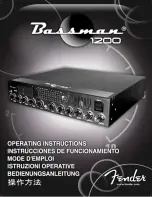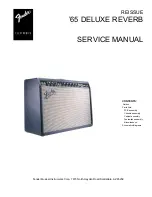Page 7
6. 300B Bias Check & Adjustment
If you are unsure about any aspect of bias contact
your retailer, Icon Audio or a competent service
engineer.
The Stereo 300
uses the ‘Fixed bias’ method of valve
operation. This method gives higher power, lower
feedback and cooler running. However you should
regularly check the bias reading using the built in meter
to ensure best performance from the amplifier.
This will
tell you that the 300B output valves are operating
normally. Adjustment is not usually needed. This is very
easy using the built in meter for V1 to V4 left to right.
1,
Tools you will need:
A small flat blade screwdriver.
2,
How to check the valves and read the meter.
(If changing valves see next section below)
If possible warm up the amplifier for 10 minutes (unless
you suspect a fault), with
Standby “off”, volume at “zero”.
Move the “bias” selector V1, These are the output valves
left to right (viewed from the front). Each valve should
have the black pointer in or near the black section. (50-
75). Precise adjustment is not necessary. This will not
affect sound quality.
Adjust if necessary, (see below) and repeat for V2/3/4.
A high reading (80+) needs adjustment, as this valve is
drawing too much current. Lower than 50 will cause no
harm but the performance will be reduced.
NOTE
3. The readings are affected by changes in your local
mains voltage. So if all four valves are slightly high or
low this is normal. Check again another time.
4.
How to adjust the bias:
Make sure you are reading the valve to adjust, e.g. read
V1 to adjust V1 screw. If the reading is incorrect, set this
by using the screw very slowly up or down until the
correct reading is obtained. They are very sensitive so
adjust very carefully. If the reading appears a little
unstable this is normally due to mains fluctuations.
You may need to repeat this a couple of times as the
adjustment of one valve may affect the other readings.
Allow 20 minutes to fully warm up.
5, If one or more valves are showing erratic readings or
you cannot set the correct voltage, then that valve is
probably faulty or out of specification. If you are unable
to set the reading high enough this usually means the
emission of the valve is too low.
Replacing the 300B Valves
Important: Do not attempt to change the 300Bs
without reading these notes. Failure to do so could
be both dangerous and damaging to the amplifier.
When replacing valves, we recommend that you use
“matched pairs” , for best performance.
Use only 300B valves.
Health & safety; High voltages are present inside the
amplifier and on exposed valve sockets when valves
are removed, so take suitable care. It is not
necessary to remove the bottom cover. Beware
valves get hot in operation!
5, Changing valves: You should if possible check the
bias setting before you attempt to change the valve(s), in
order to familiarise yourself with the procedure.
Replace and bias one valve at a time. Remove the
first old valve and fit the replacement. Switch on and
measure and adjust the bias.
Do not allow the reading to go above 95
. Don’t worry
how low the reading goes this will not cause damage.
Continue in the same way and fit both valves. Do
final adjustment when the amplifier is fully warmed
up.
If all is well there should be no more than a barely
detectable hum from the speakers, and the amplifier
should sound OK when tested.
6, If you cannot set up the bias then the valve is
probably faulty. If the valves are brand new, you will
need to check again after approximately 10 & 100
hours, after that only occasionally or if you suspect a
problem.
7, To avoid damage to the amplifier and electric
shock hazard you must use only valves marked
300B, and 6SN7/6N8/CV181 Or that you know to
be direct equivalents.
Use only valves which you
know to be new or good condition and test the
amplifier thoroughly before resuming normal use.
8, Replacing the small valves:
These are four
6SN7/CV181 valves.
None of these
requires any s
et up procedure. It’s just ‘plug and
play’, although care should be taken when removing
and inserting not to break the centre spigot.
Icon Audio are happy to check your valves Free of
Charge if you send them to us in Leicester. We will
also gladly check you ST300 and re-bias free of
charge for personal callers. (By appointment please)
The 3 fuses inside this amplifier are critical safety
parts They should only be replaced with the same
type. These are available without charge (in the UK)
from Icon Audio. Outside the UK postage is
chargable.


















